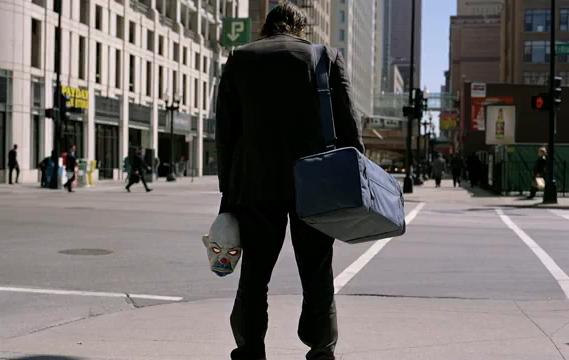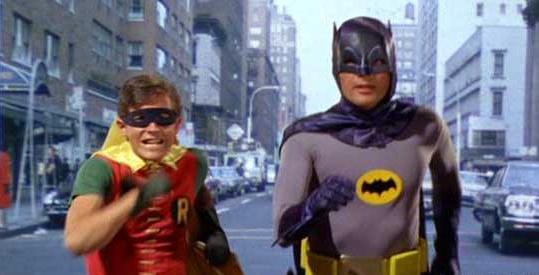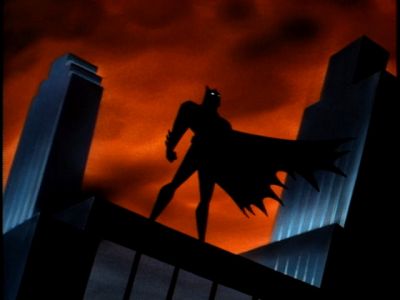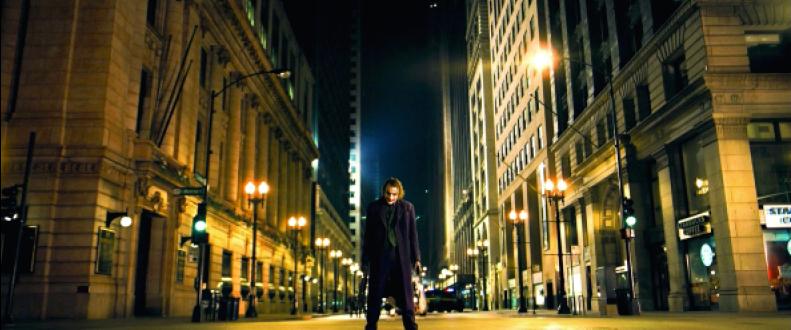 It was Washington Irving who pegged New York City with the alias of “Gotham” back in 1807, and modern readers of Batman comic books now know Gotham City as a stand-in for the Big Apple – a dark caricature of America’s great East Coast commercial capital, where the titular crusading vigilante battles a rogues gallery of often-costumed criminals. In fact, Gotham City’s classic comic book look and feel has usually adhered to Batman writer, Dennis O’Neil’s guiding artistic vision of “Manhattan below 14th Street at eleven minutes past midnight on the coldest night in November.” And yet, when Batman swung onto TV in 1966, the Gotham City that viewers saw bore an unabashed resemblance to the sunny Los Angeles cityscape where the campy series was shot on a studio set. Here, Adam West’s spandex-clad Batman has twice-weekly daylight adventures in thoroughly modern L.A.-style Gotham, where local police are outmatched by colorful villains with highly-stylized schemes.
It was Washington Irving who pegged New York City with the alias of “Gotham” back in 1807, and modern readers of Batman comic books now know Gotham City as a stand-in for the Big Apple – a dark caricature of America’s great East Coast commercial capital, where the titular crusading vigilante battles a rogues gallery of often-costumed criminals. In fact, Gotham City’s classic comic book look and feel has usually adhered to Batman writer, Dennis O’Neil’s guiding artistic vision of “Manhattan below 14th Street at eleven minutes past midnight on the coldest night in November.” And yet, when Batman swung onto TV in 1966, the Gotham City that viewers saw bore an unabashed resemblance to the sunny Los Angeles cityscape where the campy series was shot on a studio set. Here, Adam West’s spandex-clad Batman has twice-weekly daylight adventures in thoroughly modern L.A.-style Gotham, where local police are outmatched by colorful villains with highly-stylized schemes.  The 1966 Batman film mixes in enough projected shots of daytime Manhattan to maintain a partial New York vibe. This proved a smart move, since by the time Batman went before cameras in April, real-life events had drastically changed national perceptions of L.A. law enforcement. In August, 1965, a botched traffic stop unleashed simmering racial tensions, which blazed into the Watts Riots – a watershed cultural event far-removed from the silly urban troubles facing L.A.’s caped crusader. 20 years later, following Superman‘s rejuvenation of the superhero film genre, Frank Miller penned 1986’s The Dark Knight Returns – later quipping, “Metropolis is New York in the daytime; Gotham City is New York at night.” Miller’s Gotham feeds off the popular reputation of an after-dark New York City where the 1970’s financial crisis and subsequent crime explosion forged a dangerous locale indeed.
The 1966 Batman film mixes in enough projected shots of daytime Manhattan to maintain a partial New York vibe. This proved a smart move, since by the time Batman went before cameras in April, real-life events had drastically changed national perceptions of L.A. law enforcement. In August, 1965, a botched traffic stop unleashed simmering racial tensions, which blazed into the Watts Riots – a watershed cultural event far-removed from the silly urban troubles facing L.A.’s caped crusader. 20 years later, following Superman‘s rejuvenation of the superhero film genre, Frank Miller penned 1986’s The Dark Knight Returns – later quipping, “Metropolis is New York in the daytime; Gotham City is New York at night.” Miller’s Gotham feeds off the popular reputation of an after-dark New York City where the 1970’s financial crisis and subsequent crime explosion forged a dangerous locale indeed. 1989’s Batman film took things a step further. The production designer, Anton Furst turned England’s Pinewood Studios into Gotham City by adhering to director Tim Burton’s vision of a place where Hell itself had burst forth with an ugly army of oppressively massive Gothic stone and industrial skyscrapers. Instead of an Empire State Building, there is Gotham Cathedral soaring high above the corruption swirling on the streets far below (a physical dynamic The Joker experiences the hard way). By exploiting his massive city set, and a miniature version he filmed with forced perspective and creative matte shots, Burton produced a surreal, yet believable Gotham that he would build up even more for the 1992 sequel, Batman Returns. After a successful run, Burton’s team stepped aside — freeing up Batman Forever and Batman & Robin, under direction of Joel Schumacher, to feature a Gotham with neon screaming from its every pore. Hell, even the street gangs were adorned in neon warpaint. The overall effect was less a stylized take on cyberpunk, than an inane excuse for bad comedy which damn-near killed the franchise.
1989’s Batman film took things a step further. The production designer, Anton Furst turned England’s Pinewood Studios into Gotham City by adhering to director Tim Burton’s vision of a place where Hell itself had burst forth with an ugly army of oppressively massive Gothic stone and industrial skyscrapers. Instead of an Empire State Building, there is Gotham Cathedral soaring high above the corruption swirling on the streets far below (a physical dynamic The Joker experiences the hard way). By exploiting his massive city set, and a miniature version he filmed with forced perspective and creative matte shots, Burton produced a surreal, yet believable Gotham that he would build up even more for the 1992 sequel, Batman Returns. After a successful run, Burton’s team stepped aside — freeing up Batman Forever and Batman & Robin, under direction of Joel Schumacher, to feature a Gotham with neon screaming from its every pore. Hell, even the street gangs were adorned in neon warpaint. The overall effect was less a stylized take on cyberpunk, than an inane excuse for bad comedy which damn-near killed the franchise.  During this same period, a more-classic film noir-infused Gotham appeared weekly on Batman: The Animated Series, and spawned a feature film, Mask of The Phantasm. This was a turn-back-the-clock reminder of Batman’s comic book roots, with a Gotham that looked more 1940’s than 1990’s, and featured a recurring Art Deco building motif that producers dubbed “Dark Deco.” By 1999, TV viewers glimpsed the future “Neo-Gotham” in Batman Beyond, which took a far-more-engaging stab at a neon landscape. Yet when the time came to shoot his 2005 live-action origin story, Batman Begins, Christopher Nolan spent three weeks filming on-location in modern-day Chicago, instead of New York. Gotham echoes Chicago in both its political corruption, and the presence of that one set piece Batman artist Neal Adams considers indispensable: “back alleys, that’s where Batman fights all the bad guys.” Primary filming on Begins was done in England, with Shepperton Studios housing the sets, but when Batman’s Tumbler hits the streets, it’s rolling through the Windy City – requiring production
During this same period, a more-classic film noir-infused Gotham appeared weekly on Batman: The Animated Series, and spawned a feature film, Mask of The Phantasm. This was a turn-back-the-clock reminder of Batman’s comic book roots, with a Gotham that looked more 1940’s than 1990’s, and featured a recurring Art Deco building motif that producers dubbed “Dark Deco.” By 1999, TV viewers glimpsed the future “Neo-Gotham” in Batman Beyond, which took a far-more-engaging stab at a neon landscape. Yet when the time came to shoot his 2005 live-action origin story, Batman Begins, Christopher Nolan spent three weeks filming on-location in modern-day Chicago, instead of New York. Gotham echoes Chicago in both its political corruption, and the presence of that one set piece Batman artist Neal Adams considers indispensable: “back alleys, that’s where Batman fights all the bad guys.” Primary filming on Begins was done in England, with Shepperton Studios housing the sets, but when Batman’s Tumbler hits the streets, it’s rolling through the Windy City – requiring production  details like Gotham license plates identical to Illinois plates. The most memorable Chicago scene from Nolan’s 2008 follow-up, The Dark Knight, features an armored car chase that initially takes the action beneath (then pops back up onto) downtown Chicago – before culminating with a semi-truck flipping over on LaSalle Street near the imposing facade of the Chicago Board of Trade Building. This Chicago landmark had doubled for center-city Gotham’s transit hub, Wayne Tower, in Batman Begins. For Dark Knight, though, Nolan shifted Wayne Enterprises to the Richard J. Daley Center, and spent three months shooting in Chicago – fleshing out Batman’s domain with a bank robbery at Gotham National (Van Buren Street Post Office) and torching a hospital (Brach’s Candy Factory on Cicero). With Nolan set for another Batman film, expect Chicago to once more don the mask of “New Gotham.”
details like Gotham license plates identical to Illinois plates. The most memorable Chicago scene from Nolan’s 2008 follow-up, The Dark Knight, features an armored car chase that initially takes the action beneath (then pops back up onto) downtown Chicago – before culminating with a semi-truck flipping over on LaSalle Street near the imposing facade of the Chicago Board of Trade Building. This Chicago landmark had doubled for center-city Gotham’s transit hub, Wayne Tower, in Batman Begins. For Dark Knight, though, Nolan shifted Wayne Enterprises to the Richard J. Daley Center, and spent three months shooting in Chicago – fleshing out Batman’s domain with a bank robbery at Gotham National (Van Buren Street Post Office) and torching a hospital (Brach’s Candy Factory on Cicero). With Nolan set for another Batman film, expect Chicago to once more don the mask of “New Gotham.”
4 minutes read
Gotham City, Illinois
4 minutes read